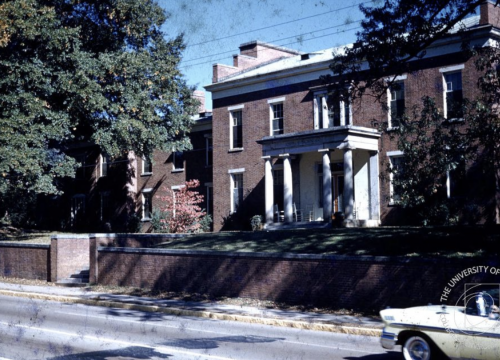Joseph E. Brown Hall – UGA 250 (1932, Category 2). Joseph E. Brown Hall is accommodates some functions related to the departments housed in the Fine Arts building nearby. It was built in 1932 as a dormitory and named for Georgia’s Civil War-era governor. Brown Hall is one of very few buildings constructed during this time period before New Deal funding became available. The dormitory has been adapted to academic use and today houses the Comparative Literature and German and Slavic Studies programs.
Brown Hall faces west toward South Lumpkin Street and is U-shaped, with the rear wings of the building forming a landscaped courtyard. Like several other dormitories at the University, Brown Hall is designed in a Colonial Revival style. A large central mass recalls Colonial domestic design with side wings that reach to end pavilions that extend to the east, creating the U-shaped plan. The building has a domestically-scaled porch at its primary entrance door with limestone Doric columns.
New entrance doors have been installed in original wood frames. The building retains its original wood double-hung windows, limestone lintels and sills, wood cornice, and a wood gable at the end pavilions. New aluminum windows have been installed over the larger windows in the center of the pavilion ends.
Removable room air conditioners are installed in some windows.
On the interior, a substantial amount of original historic fabric remains. Minor renovations include the installation of some new doors, closing of door transoms, fluorescent light fixtures, and floor finishes. Renovations did not necessarily respect the historic character of the building. Otherwise, Brown Hall retains a good degree of historic integrity. It retains integrity and appears to contribute to a National Register-eligible historic district. It is assessed as a Category 2 resource.
Landscape Resources
Landscape features associated with this character area include the road corridor, paved walks that edge it to either side, a metal barrier to protect pedestrians, street tree plantings, shrub plantings, light poles, walls and stairs, and turf. The entrance to Baldwin Hall is marked by two boulders etched with petroglyphs.
Located at the northwest corner of Baldwin Street and East Campus Road, south of Baldwin Hall, is the Latin American Ethnobotanical garden. Historic aspects of the landscape include the patterns of spatial organization and some of the tree plantings and turf areas.

